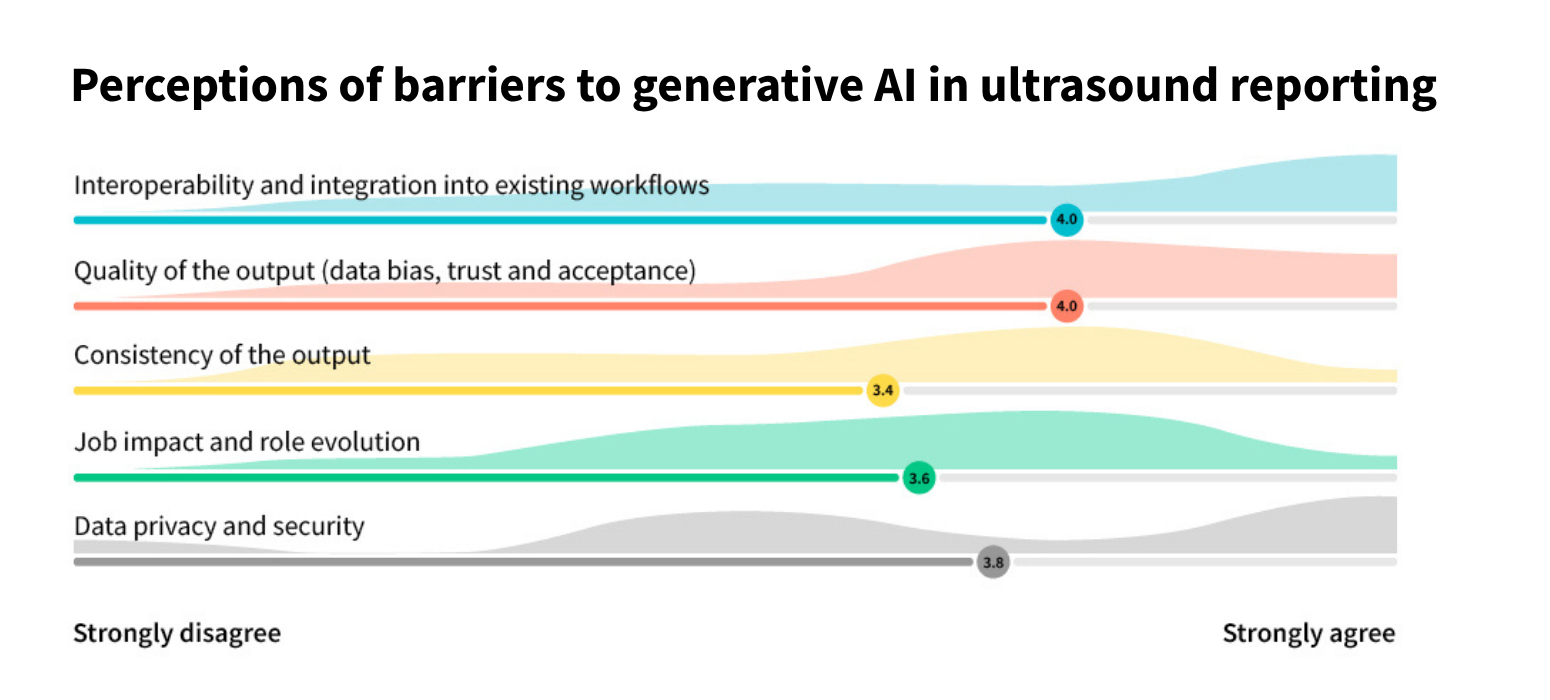Generative AI is reshaping healthcare, and its emerging role in ultrasound reporting is gaining attention. To ensure we are aligning innovation with clinical realities, GE HealthCare surveyed a group of North American radiologists who specialize in ultrasound. We asked where they see promise, what benefits they prioritize, and where they still have concerns when it comes to integrating generative AI into ultrasound reporting workflows. Their responses offer a compelling snapshot of how this technology is being viewed today—and where it may be headed tomorrow.
This three-part series explores what we learned. In Part 3, we sough input on perceived barriers to generative AI adoption.
Top-ranked barriers to generative AI in ultrasound reporting
To better understand what might slow or stall adoption, we asked radiologists to rate a series of potential barriers to implementing generative AI in ultrasound reporting on a scale from 1 (strongly disagree) to 5 (strongly agree). Their responses revealed two standout concerns:
- the integration of generative AI into existing systems
- the quality of AI-generated output
Interoperability and integration challenges
Two-thirds of the respondents either agreed or strongly agreed that integration into existing systems is a top barrier. This suggests a strong emphasis on ensuring generative AI tools can fit naturally into today's clinical workflows, without adding extra complexity.
This concern is not unique to ultrasound. Across healthcare, integrating AI into well-established imaging and reporting systems remains a hurdle. Many radiology departments are built around complex ecosystems with finely calibrated PACS, RIS, and EMR integrations. AI tools that require significant workflow adjustments or fail to integrate cleanly with existing infrastructure risk slowing adoption, even when their potential value is clear. Radiologists' emphasis on interoperability reflects a broader industry truth: new technologies must meet clinicians where they are, not ask them to radically change how they work.
“No matter how powerful an AI tool is, it has to be able to plug into the systems radiologists already use every day,” says Ravi Nagavarapu, Senior Global Product Manager, Digital Ecosystems for Medical Device Customers at GE HealthCare. “If it disrupts their workflow or demands too much change, adoption becomes a much tougher sell, even if the value is there.”
Concern about generative AI bias and quality of output
There was equally strong agreement that the quality of generative AI driven outputs, including concerns over data bias, trust, and accuracy, may be a barrier. High ratings in this area may reflect unease about the reliability of AI-generated content and the need for oversight to ensure accurate reporting.
In the post-survey discussion, participants elaborated on their mixed feelings about generative AI’s potential to address bias. Some believed the technology could help reduce variability by removing human subjectivity from reports. Others expressed concern that bias could instead be introduced via the data used to train generative AI models. As one participant cautioned, “We're going to have to be very vigilant about whether we trust what's being told to us or whether we want to question it on a very large scale.” Transparent disclosure of how algorithms are built and trained was viewed as a critical strategy to help reduce these concerns.
“Trust is everything in clinical decision-making,” says Nagavarapu. “Radiologists need to understand how an AI model was trained, what kind of data it was exposed to, and whether it reflects the diversity of cases they actually see. Without that transparency, it’s hard to trust the output, no matter how fast or impressive it looks.”
Mixed perspectives on security
Responses around data privacy and security were less consistent, with a broad spread from "strongly disagree" to "strongly agree." This variability suggests that while some radiologists see security as a major concern, others are either more confident in current safeguards or are less focused on it as an immediate barrier. Regardless, ensuring robust data security remains essential for building broader trust in generative AI solutions.
Impact on the role of radiologists
Interestingly, concerns about job loss or role evolution were not ranked as major barriers to adoption in the survey results. However, the post-survey conversation revealed more nuanced feelings.
“I don't think any of us want to think that the computer is going to do the diagnosis for us,” one participant reflected. “I mean, when you're looking at people who their entire lives priding themselves on the ability to treat the diagnosis and the correct diagnosis from the observations that would make. And I would not personally want the computer to come in and tell me the answer because otherwise I could just stay home and watch TV.”
Similarly, another radiologist expressed skepticism about trusting AI-generated reports without personal validation: “I ranked that [quality of output] high because again, you're asking me to trust the computer to do my job for me. That's going to be a barrier for me. I'm going to read it anyway. You can say whatever you want, but I'm still going to do it the way I've always done. I suspect the barrier will be lower for the new trainees.”
Together, these comments suggest that while radiologists may not fear outright job displacement, they do value maintaining professional expertise and autonomy in diagnosis.
The future of generative AI and ultrasound reporting
Among the radiologists surveyed, there were pockets of enthusiasm for the future of generative AI in ultrasound reporting, but also a clear view of the challenges ahead. By understanding and addressing perceived barriers like interoperability, bias, and trust, vendors and clinicians can work together to shape AI tools that enhance, rather than disrupt, the practice of ultrasound imaging.
Read the complete series on perceptions of generative AI in ultrasound reporting:
Part 1: Radiologists rank potential use cases
Part 2: Standardization and efficiency take center stage
Part 3: Understanding barriers to adoption
REFERENCES:
Internal data from a GE HealthCare focus group, October 2024
©2025 GE HealthCare. GE is a trademark of General Electric Company used under trademark license.
JB35594XX


